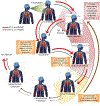Advances in the understanding of Mycobacterium tuberculosis transmission in HIV-endemic settings
- PMID: 30554995
- PMCID: PMC6401310
- DOI: 10.1016/S1473-3099(18)30477-8
Advances in the understanding of Mycobacterium tuberculosis transmission in HIV-endemic settings
Abstract
Tuberculosis claims more human lives than any other infectious disease. This alarming epidemic has fuelled the development of novel antimicrobials and diagnostics. However, public health interventions that interrupt transmission have been slow to emerge, particularly in HIV-endemic settings. Transmission of tuberculosis is complex, involving various environmental, bacteriological, and host factors, among which concomitant HIV infection is important. Preventing person-to-person spread is central to halting the epidemic and, consequently, tuberculosis transmission is now being studied with renewed interest. In this Series paper, we review recent advances in the understanding of tuberculosis transmission, from the view of source-case infectiousness, inherent susceptibility of exposed individuals, appending tools for predicting risk of disease progression, the biophysical nature of the contagion, and the environments in which transmission occurs and is sustained in populations. We focus specifically on how HIV infection affects these features with a view to describing novel transmission blocking strategies in HIV-endemic settings.
Copyright © 2019 Elsevier Ltd. All rights reserved.
Conflict of interest statement
Declaration of Interest
All authors declare no conflicts of interest.
Figures

Comment in
-
Understanding tuberculosis transmission might be the gamechanger we need.Lancet Infect Dis. 2019 Mar;19(3):e63. doi: 10.1016/S1473-3099(18)30741-2. Epub 2018 Dec 13. Lancet Infect Dis. 2019. PMID: 30554994 No abstract available.
References
-
- Shankar EM, Vignesh R, Ellegard R, et al. HIV-Mycobacterium tuberculosis co-infection: a ‘danger-couple model’ of disease pathogenesis. Pathog Dis 2014; 70(2): 110–8. - PubMed
Publication types
MeSH terms
Substances
Grants and funding
LinkOut - more resources
Full Text Sources
Other Literature Sources
Medical

